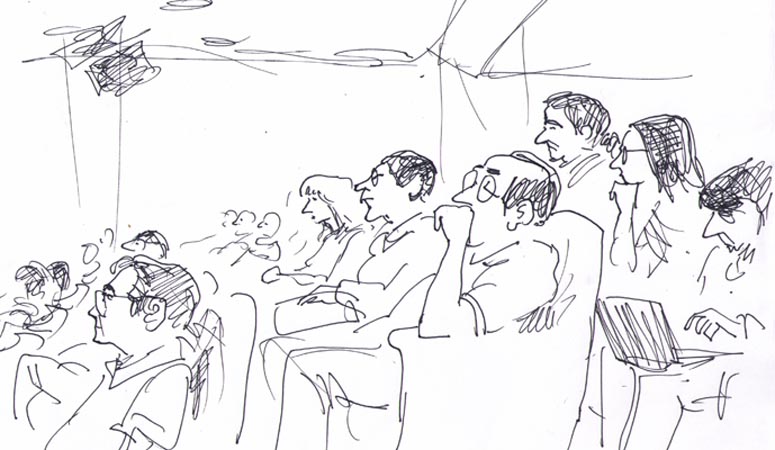
I've just come back from the 21st annual International Conference on Particle Physics and Cosmology (COSMO-17) held at the Paris Diderot University campus in Paris, France, August 28–September 1, 2017. The meeting was hosted by the Astroparticle and Cosmology Laboratory (APC). I imagine readers are asking: "So then, how did it go?"
Reactions were the same as in Frankfurt. I would even dare to say: it was worse.
First of all, Internet users need to know what is really a participation to an international conference when presenting a poster. This is a rump presentation. No comparison to oral presentations, in a room, which are the only ones where people can "react", or simply wish to react.
There were 193 attendees from 24 countries, with a lot of Parisian researchers. An auditorium was packed to standing room only, so people sat on the stairs. I will detail these interventions below. But it is worth describing what international symposia became, at least in this specialty today. Speakers present their work, during 30 to 40 minutes, illustrated with slides on a big screen.
In the rooms during these presentations, half of attendees – sometimes two out of three – have their laptop on their lap. What are they doing? When you take a look at their screen, it has nothing to do with the presentation they are supposed to listen to. As everyone is connected to the Internet, one can receive, read and send emails and text messages during the presentations. I was personally seated next to a young Russian woman who works in Bonn, Germany, who spent all these sessions with her eyes on a Cyrillic text displayed on a small tablet, without paying any attention to the talks. She did not hesitate at all to tell me that she was reading… a novel!

In many sessions I would say that less than half of attendees do listen. By the way it was the same in Frankfurt. When the presentation ends, the chairman thanks the speaker very much, and the room is then overwhelmed with applause. I witnessed the same phenomenon in Frankfurt. But back in the day, the few times I've been able to attend an international conference, I've never seen this. One can very well distinguish between "normal" applause and what I saw. It is almost a standing ovation. As if the audience wishes to apologize for its lack of attention, or to validate the content, which is usually completely empty, when it comes to theoretical lectures.
So what? Why do these researchers attend such conferences? For the most part of delegates, it can be summed up as the possibility to mention their participation to an international event in an activity report. The barons of research can also meet, present the development of their powerful observational instruments, to the tune of tens millions of dollars. Yes, observation is as fit as a fiddle. Technical means make it possible to collect more and more precise data, to make authentic discoveries, like that of the Great Repeller in January 2017.
This lack of attention, during the presentations, may seem staggering. But in the theoretical field concerned, there is no unity. The specialist of the right hand does not hear anything to what the specialist of the left hand has to say. This is like an overdose of one-way talks.
At this international conference on cosmology held in France, I didn't find any of the French specialists: neither Thibaud Damour, nor Françoise Combes, nor Aurélien Barrau, nor Alain Riazuelo, not even Marc Lachièze-Rey, who is a member of the laboratory hosting the symposium, the APC (Astroparticle and Cosmology Laboratory).
I made the count of participants, in descending order:
Japanese: 32 (…)
American: 31
French: 27
English: 27
Korean: 12
German: 10
Dutch: 9
Spanish: 8
Canadian: 8
Swiss: 6
Polish: 5
Chilean: 4
Mexican: 4
Portugese: 2
Estonian: 2
Brazilian: 2
Finnish: 2
Italian: 2
Iranian: 2
Chinese: 1
Indian: 1
Swedish: 1
Israeli: 1
Emirati: 1
Total: 192 attendees, from 24 countries! A major annual international milestone in cosmology.
By the way: not even one French journalist. If they echo this event, it will be according to second-hand testimonies. I called upon four journalists from the Ciel & Espace magazine; none came.
I presented two posters on the scheduled day (Tuesday, 29 August 2017). But I should not expect any reaction other than curiosity (at best) with respect to something as enormous: to consider replacing Einstein's equation with two coupled field equations. In the second poster, I presented my alternative to the stellar black hole model: the leaking neutron star, which evacuates any mass in excess that would be accreted from the stellar wind of a companion star. I will dedicate an entire video to this subject.
I pass on discussions with young Canadian, Japanese, and other researchers… who showed a vague curiosity, but alas nothing more.
MONDAY.
I started attending a lecture devoted to dark energy, presented by Italian researcher Flippo Vernizzi, from the Theoretical Physics Institute (IPhT) of CEA-Saclay. You can easily find his professional track record on Google Scholar. He is the archetype of today's theoretical physicist: scalar fields, quintessence, quantum gravity, etc. In his presentation on dark energy, he speaks of "ghosts", "massive gravity", "quintessence", "k-essencce", "scalar-tensor theory". I discover the word "Symmetron" (…). He concludes: "Something is missing in our schema". Certainly.....

Filippo Vernizzi, dark energy theorist
Astrophysics departement at CEA-Saclay
I go to meet him at the coffee break. He faces me with evident displeasure. After having evoked the main lines of my approach (but he obviously does not listen) I go on to quote what may have an impact on his field, quantum mechanics:
"Currently, the accelerating expansion of the universe implies to assume, in quantum field theory, negative energy states. Do you agree? As you said in your main presentation (in the face of all attendees, not to little groups in smaller rooms during the afternoon), this cosmic acceleration implies a negative pressure. Hence negative energy states."
I continue despite his pout of annoyance:
"A pressure is also an energy per unit volume, i.e. an energy density."
"No way!" He protests. "A pressure is a force per unit area. That has nothing to do with energy. Even a negative pressure implies a positive energy."
"I am sorry but this is a mistake. If you want to address this issue of pressure as a force per unit area, let's go. This is a subject I know very well since I did a lot of kinetic theory of gases. Place a wall in a fluid medium. It undergoes collisions from incident particles. These will then transfer some of their momentum to the wall, corresponding to the component of their velocity vector V perpendicular to it. Do you agree?"
"Yes…"
"Yet this momentum is mV. Therefore if a fluid in contact with a wall has a negative pressure, it does not repel the wall, it attracts it. So if we are talking about a negative pressure, such collisions are due to particles with a negative momentum. Since E = mc² the energy of these particles is also negative. Do you agree?"
"Yes, yes — Don't get upset. OK this energy is negative, you're right. I will now take it into account." (…)
"That is not all. When you talk about instability issues due to negative energy states, you think of an emission of energy using positive energy photons. But negative energy particles emit negative energy photons. And that, the quantum field theory does not handle it."
"Yes… Fine — I will take this into account, I promise."
Annoyed, he immediately turns on his heel and walks straight away.
He obviously played me for a fool, refusing any discussion. I could not get anymore. These people are fleeing from any dialogue.
We return to the auditorium. Next presentation: Robert Brandenberger, McGill University, QC, Canada. Title of his communication: "Update on Bouncing and Emergent Cosmologies". These are the trending ideas. He presents himself as "a string theorist". Every buzzing word happens there: the "Big Bounce", "quantum gravity", the "string gas" (…), the "Hagedorn temperature" (beyond which hadrons can no longer exist – estimated at about 1030 K – one even read that some think such temperature would be "unsurpassable").
Brandenberger refers to inflation as the only theory able to solve the horizon paradox. He concludes:
"There is no alternative to inflation theory."
At the end of his presentation during Q&A, I take the floor:
"As an alternative to inflation theory, what do you think of a variable constant model, which in particular implies VSL, a variable speed of light, which challenges this inflation theory? I published peer-reviewed papers on this subject as from 1998 then 1995, where I propose a joint variation of all physical constants as a gauge process —"
But Brandenberger immediately dodges the issue, redirecting me toward a young Canadian researcher he points to in the crowd, who also would have worked in this direction:
"You'll be better off speaking with this researcher than with me."
End of discussion. Actually Brandenberger has very fixed ideas. Axions, string gas, quantum gravity… that's serious. But a varying speed of light: what an idea! Let the wacky guys discuss among themselves.
I will have an exchange afterward with this young Canadian, who is a kind person by the way, who said to me:
"I had a look at your poster and I talked with colleagues. It seems interesting. But as for that light velocity model, I did not do much, you know. Nothing to do with your work in this area."
Late morning: Eric Verlinde's presentation on "Emergent Gravity". This is not a review of the empirical ways of modifying gravity, as the Israeli Milgrom does with MOND, but of a very complex theory that makes gravitation an "emerging" property. I quote the key phrase:
"By using entanglement in the code subspace (…) we can reproduce the puzzling behavior of the region of duality (…)"
TUESDAY.
I take part after the second presentation of the second day, situating the different elements of concordance between the current dominant model (ΛCDM model) and observational data like the CMB. Silvia Galli, of the Paris Astrophysics Institute (IAP), is engaged in this long survey.
I raise my hand. Someone give me the mic:
"How do you consider the compatibility between the Lambda-CDM model and the Great Repeller?"
"… The… What?"
"The Great Repeller, or Dipole Repeller, presented in Nature in January 2017 by Hoffman, Courtois, Tully and Pomarède, where they show a void region 600 lightyears away, totally emply, that repels galaxies, including ours at 631 km/s."
She has no recollection of such a thing and stands there goggling. Then others in the room confirm my sayings. There is a big moment of embarrassment when the IAP researcher finally says:
"I am not aware."

I did not think I would have created such awkwardness with this specific question. Let's skip over that.
In a subsequent presentation by Daniel Harlow, MIT, which deals with black holes, quantum information and the "holographic principle," I try to derive interest in the foundations of the black hole model:
"I would like to point out that the black hole theory is based on a publication made by Karl Schwarzschild in 1916. But who knows that Schwarzschild at the beginning of 1916, just before his death in May, published not one paper, but two?"
Incomprehension in the room. I go on:
"The content of this second article, which was only translated in English in 1999, is very important. Who knows that this second paper exists?"
Silence… So I ask:
"Then, among black hole specialists here, who has read Schwarzschild's first paper, that of January 1916?"
Deafening silence.
This confirms what I supposed. None of black hole specialists read the original papers from Schwarzschild, Einstein, Hilbert. They have always worked, since the fifties, based on comments after commentaries. I do not insist.
WEDNESDAY.
The third day, Hendrik Hildebrandt, head of the Emmy Noether research group at the astronomy institute AIfA of the University of Bonn, presents the techniques of weak lensing, which distorts the images of galaxies. Everything is geared towards the reliability of the conclusions drawn from this analysis, with respect to "bias" i.e. possible errors due to a hypothesis posed for data processing.
So Hildebrandt's interest concerns the reliability of these analyzes.
I speak:
"In this type of processing of observational data, there is a basis hypothesis, that this effect is due to dark matter of positive mass. A few years ago, a group of Japanese researchers published a paper in Physical Review D referring to the fact that if a positive mass generates an azimuthal distortion, a negative mass will create a radial distortion."
The document I referred to is:
Izumi, K. et al. (2013). "Gravitational lensing shear by an exotic lens object with negative convergence or negative mass". Physical Review D. 88: 024049. doi:10.1103/PhysRevD.88.024049. arXiv:1305.5037.
I continue:
"Have you thought about trying to analyze your data, about a million galaxies, by imputing the distortions, not to a positive mass, but a negative mass? I think this would require only a small change in your processing program."
"We already find radial distortions," Hildebrand answers, "when there is a gap in dark matter. Such a gap acts like if it was negative mass there."
"Of course, but here I am talking about genuine negative mass concentrations, similar to that which creates, I think, the effect of the Great Repeller."
Obviously, my remark disconcerts him. He did not really understand the scope of my proposal and must ask himself "Who is this guy?" Where does he work? I never saw him before, do not know him…"
I do not insist.
It's very difficult to harass people like that. After his presentation, Hildebrandt entered into great conversation with other colleagues, probably involved in similar studies. I am… completely exotic in this game. Negative masses? What an idea – !
In another presentation by a researcher from the local French lab, the APC (Astroparticles and Cosmology laboratory) of the Paris Diderot University, Chiara Caprini discusses the results of numerical simulations through which "we hope to learn more about the physics of dark matter". She adds:
"About galaxies, they are still very mysterious objects."
At this moment I am thinking about the work I initiated in 1972, and which I am currently finalizing, on galactic dynamics (yes, I have resumed this work 45 years after). A work based on a joint resolution of the Vlasov equation and Poisson's equation.
She delivers a quite exhaustive talk.
I ask again for the microphone and say:
"Since Monday, people in the audience understood that I do not believe in the existence of a dark matter as positive mass particles, that no one observes, whether it is in tunnels, mines, on board of the International Space Station, or in the LHC. I personally think that these astroparticles will never be detected, because these invisible elements are not where you are looking for them. I believe that negative mass, invisible, lies at the center of the great cosmic voids and between galaxies, of which it ensures their confinement and immediately favors their formation at the end of the radiation-dominated era. It is also this surrounding negative mass which produces their spiral structure, by dynamic friction. I think that if you introduce other data into your simulations, with a negative mass of high density, gravitationally self-attractive, but which interacts with positive mass according to mutual repulsion, you will find many interesting things. The large-scale structure, for example, as described by Israeli Tsvi Pirán, taking the shape of adjoining soap bubbles."
Sentences that immediately create a stupor, triggers a general silence. They must think "this guy really pisses everybody off with his negative masses!" The presenter is bothered, no longer knows who to turn to, what to say. I would make a comparison with an intervention in a religious service. Imagine yourself, in an occidental country, inside a church, taking the floor and suddenly saying to the priest and the faithful:
"How do you know that the base of your belief is a reality, that the story you are talking about as facts actually happened?"
Stupefaction would be comparable. We are not anymore in a scientific meeting where ideas are debated but, in the case of purely theoretical parts, in a series of religious services, a display of beliefs free from the slightest observational support.
The young woman continues and talks about how simulations show the influence of supermassive black holes on galactic dynamics.
I raise my hand again:
"You are talking of giant black holes. But what proof do you have they are indeed black holes?"
"Errr — One relies on increasing star velocities near the galactic center."
"Of course, and their motion implies the presence of an object of very large mass there. But if you put, in a sphere having the radius of Earth's orbit, a gas with an average density that would be that of water – which corresponds to the average density inside the Sun – then you find your four million solar masses. As for the supposed black hole, where is the spectral signature that confirms its presence? You know that when the Chandra satellite was launched 17 years ago, we expected to receive a powerful flush of X-rays. But we got nothing. You also know that in 2013, a bunch of interstellar gas passed by and that his behavior was not at all what he should have had if it passed near a black hole. The observation totally contradicted the predictions based on the simulations."
Such comments should trigger a debate among scientists present there. But no, nothing. It is to believe that Science is dead. There is only a sparkling look in the eyes of a few young people who suddenly hear a different speech. But for most of them, and for their bosses, I am only a Charlie who disrupts the smooth running of the symposium.
Thus I think I must try to hook up "big shots" and at the coffee break I decide to approach George Smoot, Nobel Prize 2006, who currently works at the Astroparticles and Cosmology Laboratory of the Paris Diderot University.
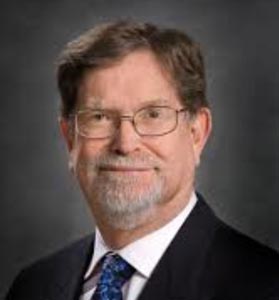
George Smoot, Nobel Prize in Physics 2006
This one had the Nobel Prize for showing that the CMB radiation corresponds to a black-body radiation. I stand at his side as he goes up the stairs.
"Mister Smoot, I would like to present my work at a seminar in you lab."
"This will be difficult as I am about to leave for Hong Kong soon."
"There is no urgency. We could save the date."
He lengthens his stride, annoyed.
"You may have glimpsed my poster. I developped a model where the universe is populated by positive masses and negative masses."
"When such opposite masses encounter, they chase one after the other and the kinetic energy of the positive mass grows indefinitely…"
"Yes, this is the runaway effect as shown by Bondi in 1957. But precisely, in my model this effect disappears. The interaction laws resulting from the Newtonian approximation with two coupled field equations cause the negative masses to become self-attracting and the masses of opposite signs mutually repel according to anti-Newton."
Smoot poured himself a cup of coffee, ostensibly not paying the least attention to my purpose. He did not give me a look at any time, did not turn his head towards me. I have never seen such rudeness in my whole life. I ended by saying to him:
"You are treating me as if I were a crackpot. But I'm a serious guy. I published my work in peer-reviewed journals —"
I haven't finished my sentence yet Smoot has already turned his back on me and is walking away. Totally shocking from this Nobel Prize.
Maybe he was briefed against me by his French colleagues, who do not allow me to present my work in any of their labs and don't even answer my emails.
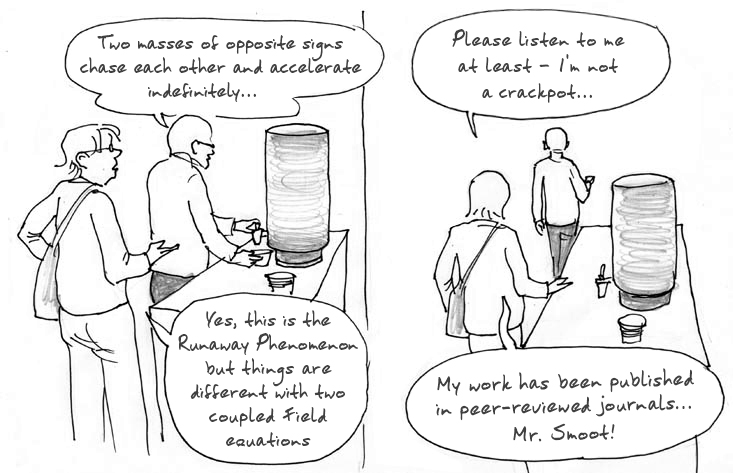
THURSDAY.
Fourth day. I decide to rest. Temperature is very hot in Paris. 31 °C (88 °F) at the end of the day, and I have trouble sleeping. These "hostile interventions" are very trying. Whatever, presentations of that day deal with detection of gravitational waves, a subject I have not yet addressed. I still go to the evening event at the restaurant "Le Train Bleu", near Gare de Lyon, where the traditional diner is held, bringing together all the attendees.
By the way: a 90-euro meal absolutely scandalous. A minion pours a finger of red wine. There were so little that one would have thought it was to taste. The cheese plate: laughable with slices 2 mm thick. The bread, semi-stale, visibly frozen. Appetizers and desserts coming directly from a supermarket. It remains the decoration, the paintings on the ceiling. The menu of this restaurant Le Train Bleu, Gare de Lyon: we would have eaten better in a snack!
I do not find the few young people I discussed with the preceding days, so I sit randomly at a table. I try to engage a bit of conversation with my right-hand neighbor, a young American. He is not a researcher but a simple student. I am then confronted with the most simplistic conservatism, typically American. This boy is already well "formatted", very sure of himself, totally impervious to anything that could deviate from what he was inculcated in his studies. Our exchange is short.
My left-hand neighbor is the director of a high-energy lab. I evoke the failure of the quest for superparticles. But nothing shakes his conviction that we must pursue all the projects in progress: "We will eventually find something" he says. The same applies to the work of the Italian Elena Aprile who, in her tunnel underground the Gran Sasso mountain, hunts for the neutralino within a ton of liquid xenon (and discovers… nothing!).
At one moment he is coming out, mockingly:
"Say, if no one has paid attention to your theory, it may be because it does not stand up?"
You can be convinced this one will not read my papers.
At Frankfurt I had sinned by timidity. It is not convenient to speak before two hundred men and women, supporting ideas diametrically opposite to theirs. Ideas which, even worse if they were confirmed, would collapse all their own work.
Frankfurt is Schwarzschild's birthplace. The conference was called the "Karl Schwarzschild Meeting" and "the young hopes of cosmology" were awarded a "Schwarzschild prize". You saw (here, my report of that conference) that a senior German researcher had confessed to me that he had never read these founding papers. In his presentation, Juan Maldacena referred to this first work, which was published exactly a century ago as "something that had created confusion, but afterward these things were cleared up."
I will show that it is exactly the opposite. There was a misinterpretation of the Schwarzschild solution by the great mathematician David Hilbert. And everyone has followed suit. The first one who noticed this was an American, Leonard Abrams, who published an article in the Canadian Journal of Physics:
Abrams, L. S. (1989). "Black Holes: The Legacy of Hilbert's Error". Canadian Journal of Physics 67 (9): 919–926. doi:10.1139/p89-158. arXiv:gr-qc/0102055.
A totally unrecognized work (Abrams died in 2001). Italian physicist Salvatore Antoci took this work over:
Antoci, S.; Liebscher, D.-E. (2001). "Reconsidering Schwarzschild’s original solution". Astronomische Nachrichten. 322 (2): 137–142. arXiv:gr-qc/0102084.
Antoci, S. (2003). "David Hilbert and the origin of the Schwarzschild solution". Meteorological and Geophysical Fluid Dynamics. Bremen: Wilfried Schröder, Science Edition. arXiv:physics/0310104.
I tried to get in touch with him, alas he did not reply.
I believe he understood that it was not good to question the fetish object of today's cosmology.
I will show (and you will understand my explanations) that the black hole is based on a topological error that has lasted for a century. At Frankfurt, I would have liked to ask all attendees if they had read Schwarzschild's papers, especially Maldacena. I bet I would have received the same negative answer, as I did in my oral intervention on Tuesday.
This is appalling. None of the specialists who make the black hole their daily bread ever read the two founding papers, published in January and February 1916 by Karl Schwarzschild, a century ago. It is true that his first article (the "exterior" solution) was translated in English only in 1975. For 59 years those who do not read German have contented themselves with "comments after comments", and mistakes have spread, on which practically nobody has returned. As for Schwarzschild's second paper (the "interior" solution) published in February 1916, three months before his death, it has been translated by Antoci only in… December 1999!
How does the milieu perceive me?
The first answer is very simple: "it does not perceive me at all". One does not pay attention to a guy who only gets a poster presentation, which in addition introduces negative mass in cosmology!
About those who witnessed my reiterated "outings" in the auditorium: what did they think? I suppose they did not understand a word of what I said. Negative mass between galaxies? Never heard of such a thing…
None came to me to find out more. In contesting the existence of black holes, and even that of dark matter, suggesting other paths of research, I was no doubt perceived as "a retired, rather rusty researcher, outside the great currents of today's cosmology", as Alain Riazuelo of the Paris Astrophysics Institute (IAP), great CGI designer of black holes, wrote me.
The general public has a totally false idea of the scientific community. People imagine scientists as scholars attentive to new ideas, ready to debate. Whereas most of them behave like religious people. In recent years, new currents have emerged which are not based on any observational basis. The most spectacular is "quantum gravity". You may know that gravitation has not yet been quantified. Any attempt to create a graviton runs into problems of insuperable divergence. But one gets the impression that by talking about "quantum gravity", to repeat these words as an incantation, the thing will eventually exist.
You just have to think about how the black hole is advertised, how it is litterally "being sold" to you. For the past thirty years, you have been served the same phrase, repeated endlessly by the media under the heel of this milieu (they sell what they are given):
"Although there is no observational confirmation of the existence of black holes, no scientist any longer doubts their existence."
Does such a phrase deserve to be called scientific? Will you continue to swallow that without reacting? Whereas we base all on a single case, that of the binary system Cygnus X-1, detected in 1964, where the companion that emits X-rays is credited with a mass of eight to fifteen solar masses (thus greater than the critical mass of 2.5 solar masses). For 50 years, half a century, it is the only case of a "stellar black hole". Distance: 6,000 lightyears. So there is obvious uncertainty about the distance measurement and the resulting evaluation of the mass of the two objects gravitating around a common center of gravity.
There are two hundred billion stars in our galaxy. Half are multiple systems, usually binaries. There would be between ten and one hundred million "black holes" in our galaxy, obviously objects that would be closer to us than Cygnus X-1. And we did not observe them for 50 years, while our observation means are refined year after year!
In the center of galaxies: "giant black holes". In ours, an object whose mass is equivalent to four millions solar masses. Immediately "it's a supermassive black hole". But this object does not behave like a black hole. The gas arround does not emit X-rays. In 1988, the Chandra satellite is placed in orbit, able to detect such radiation. It is pointed toward the center of the Milky Way: nothing.
"It is a replete black hole" we have even heard!
A flow of interstellar gas goes towards it in 2011. Simulations are set up to show what will happen: the gaseous mass will deform and be aspirated.
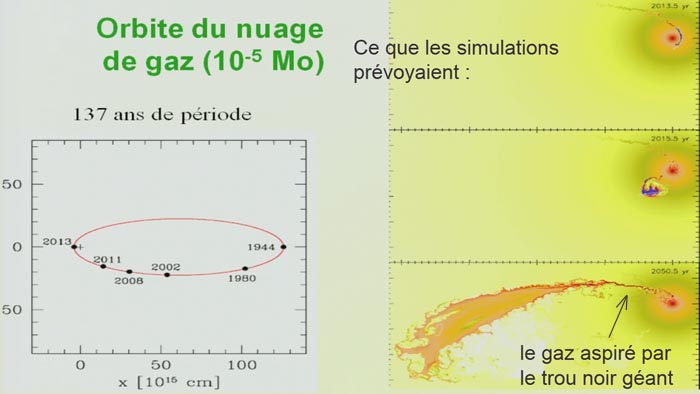
Summer 2013: the stuff goes nearby and… nothing. For that matter, see Françoise Combes' conference on giant black holes at 12:33 (in French).
Would it be… an anorexic black hole?
You heard of quasars. Here again it is a black hole that… etc. The model? In the same video: when the black hole has eaten enough, it "spits"… The mechanism of this cosmic hiccup? Unknown, not described.
This is insane! It is astrophysics and cosmology today. Words, bluff, theories that are not. Arguments of authority, mythical visions and computer-generated imagery. Some even add a great flight of lyricism of poetic ambition. Confrontation with observation? Why, is it so important? Let's go ahead, as with this multiverse twaddle!
FRIDAY.
I sat down in the front row. This time the chairman warns me about the tight schedule and that long questions will not be allowed. A dissuasive speech.
A Korean makes a presentation about the different candidates for dark matter. The whole pixie dust range is reviewed.
At the end of the presentation I raise my hand. But the chairman, who is two meters away from me, turns his head away, ostensibly ignoring me, and runs into the corridor to look for other questioners in the room. In the first row, I remain the arm completely raised.
That kind of strategy is well known. Two or three speakers are selected and are given the floor, after which the chairman turns back to the potential disturber, saying:
"I am sorry, but we have now run out of time."
But he finds only one person who asks to speak. He then returns to me and to cut short any remarks I say to him:
"I want to ask one question. Only one."
All attendees in the room heard. He reluctantly gives the microphone to me.
So I ask:
"In this context of the behavior of dark matter candidates, how do you consider the effect of the Great Repeller?"
The Korean guy stares at me with great big round eyes. He looks shattered. As an Asian he is "loosing face". I insist:
"You know, the Great Repeller, as shown last January by Hoffman, Courtois, Pomarède and Tully. A void 600 million lightyears away, where there is nothing, yet which repels galaxies."
Here we go again. The Korean is not aware. I do not insist ….
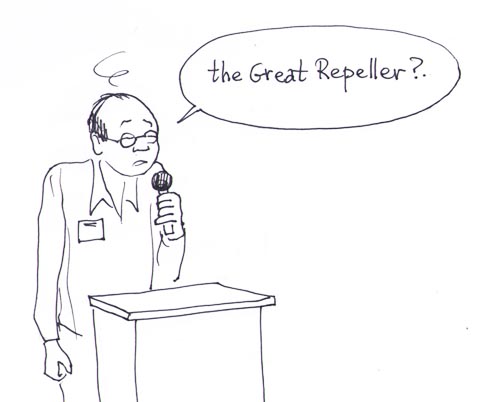
Each time I spoke, I tried to keep a posed tone, to avoid appearing as an energetic nutcase. A difficult exercise in such a context. I forced myself to do it. I was present at this conference thanks to the financial help of internet users. So I had to show how far things had gone.
My wife said to me:
"Having created such embarrassing situations, what you risk is to see the doors of international conferences in this specialty closing in front of you."
Highly possible. In future conferences this shall happen the same way, obviously. Yet at no time I was aggressive, or insulting. But all my speeches hit a nerve. I think the most frightening thing was the Italian theoretician, a dark energy specialist, who told me that negative pressure did not go hand in hand with a negative energy density. How could he say such bullshit? There I made myself a mortal enemy, one more.
Hopefully, the continuation of the JANUS videos, subtitled in English, will eventually have an international impact and trigger interest among some scientists. Not necessarily positive, by the way. Think of this remark of this young Italian researcher in Frankfurt, who had said to me:
"I saw your papers about your Janus cosmological model. I am looking at how you are welcomed here. How can you expect these people to do anything but turn their back on you? What you are proposing is to destroy the very basis of their work!"
The first barrier is scepticism. Some glimmers of curiosity were lit up among young people, but nothing more. During the dinner, Thursday evening, when I tried to speak with a young American researcher on my right at the table, he obviously considered me as a wacky man, even when I quoted my 2014 and 2015 peer-reviewed papers. He was as thick as the others. What do these "young researchers" look for? An exciting thesis topic? No. They are searching for a position perspective within a group of researchers of the same kind, where they can easily copublish. Or a well-paid contract under the leadership of a powerful boss.
To believe that young researchers will turn to these novel ideas is an illusion, I think. They have everything to lose, like their bosses.
A reader told me about this 24-year old young woman, Sabrina Pasterski, presented as the future Einstein.
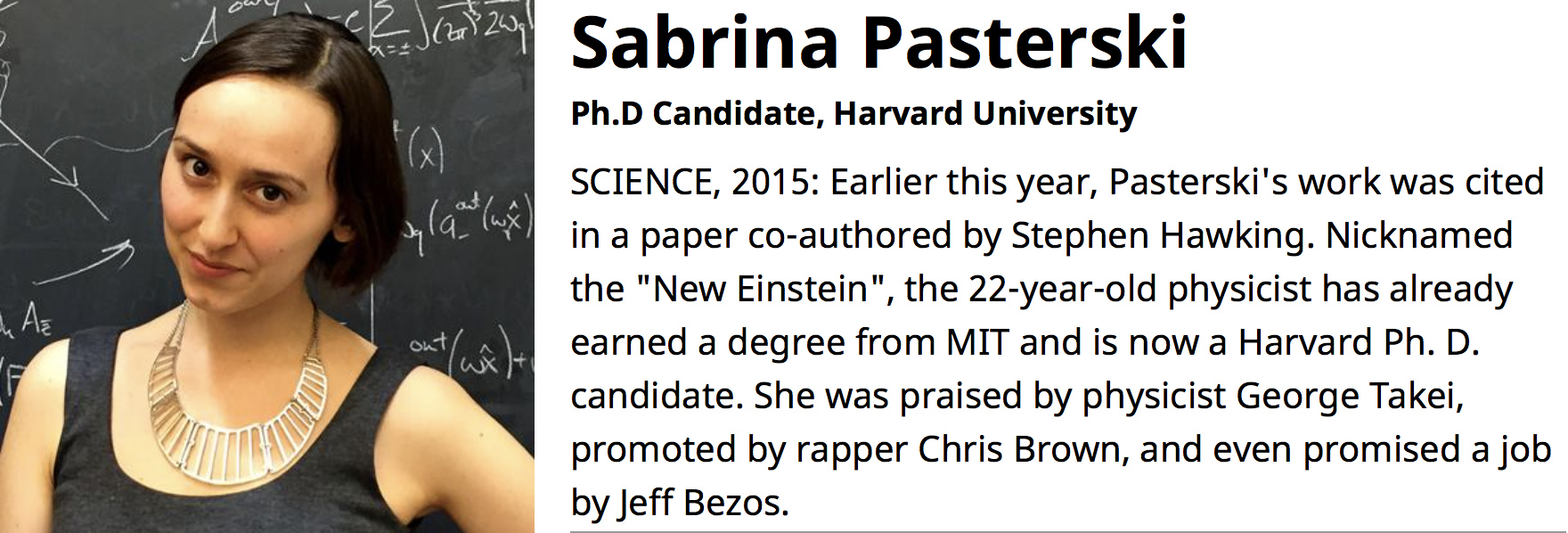
Sabrina Pasterski's profile on Forbes
It is true that her history is surprising. See the video where she is being shown building a light aircraft, aged 13-14, which she will fly alone at 16 years old. Having integrated the MIT, she immediately showed great dispositions for theoretical physics and then joined the research team of Andrew Strominger.
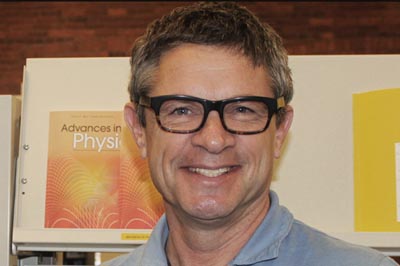
Andrew Strominger
Aged 61 (and therefore relatively young), he has received numerous awards for his contributions to string theory.
His young disciple has a website: physicsgirl.com which reports that she has already been invited everywhere, that the press speaks of her, all over ther world.
I'm told: "Maybe that girl…?"
I also have the email address of this young "genius". I'll write to him as well.
I am going to write to Strominger, to ask him to come to meet him and present my ideas and works. The financial help of Internet users would allow me to carry out such a mission. But will he answer?
Anyway, today I am writing messages to two labs, to the seminar managers:
– of the Astroparticles and Cosmology (APC) laboratory of the Paris Diderot University, where George Smoot and Marc Lachièze-Rey are attached.
– of the Astrophysics Laboratory of CEA-Saclay, where theoretical physicist Filippo Fabrizzi works.
asking to be able to present my works there.
I bet that, again, nobody will answer me. And then I will mention these behaviors in the Janus videos, which will remain in place without any time limit, with the names of those concerned. Because such systematic avoidance is abnormal.
It is a sign that this part of science is getting worse and worse.